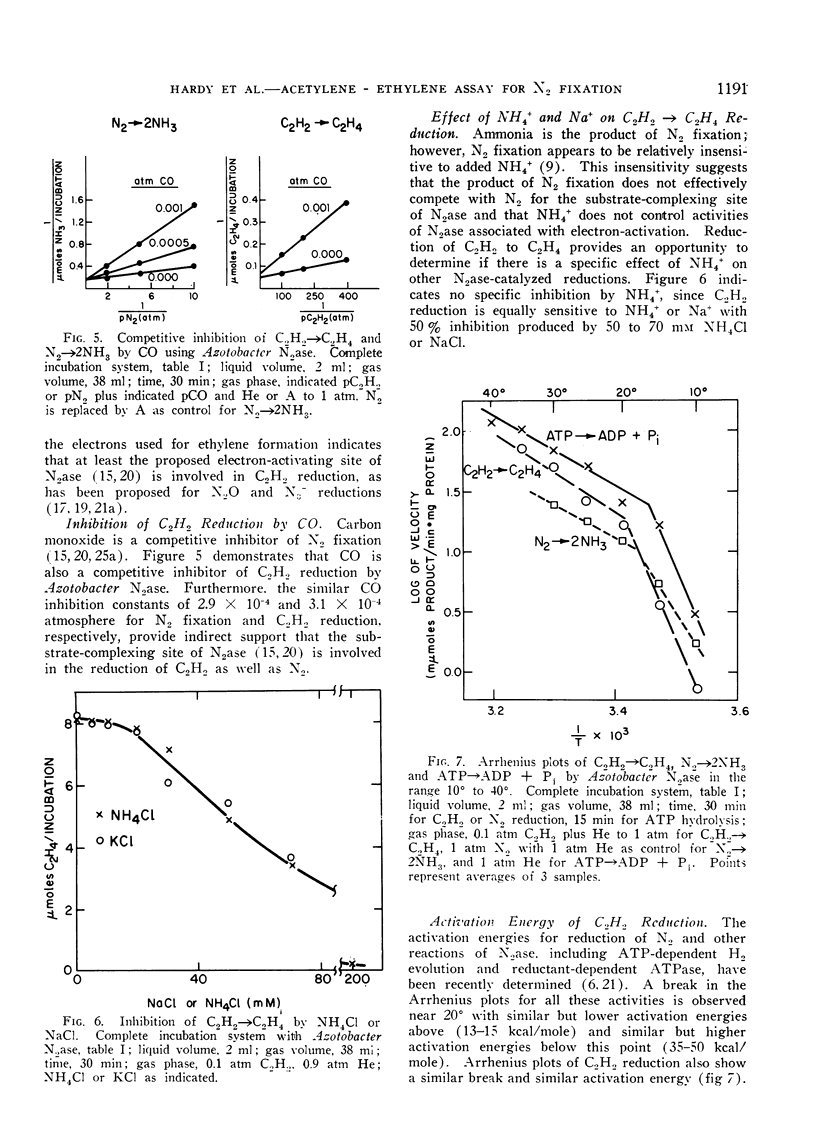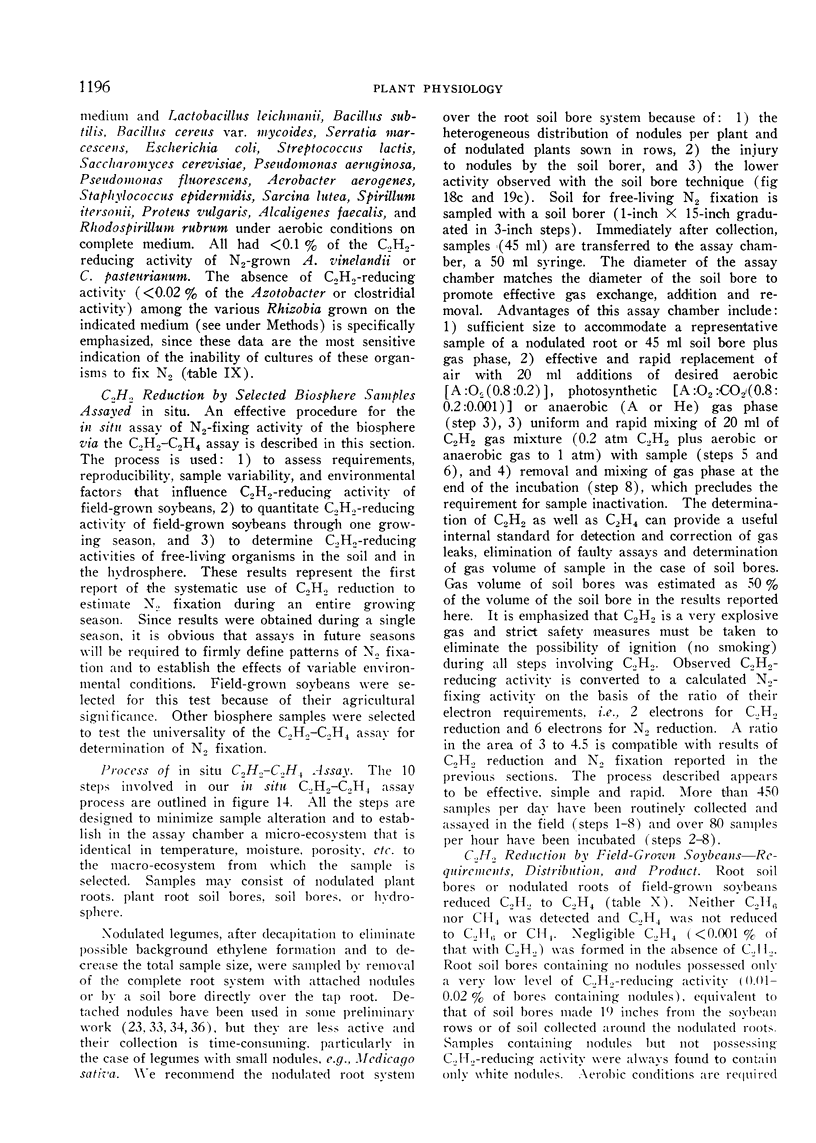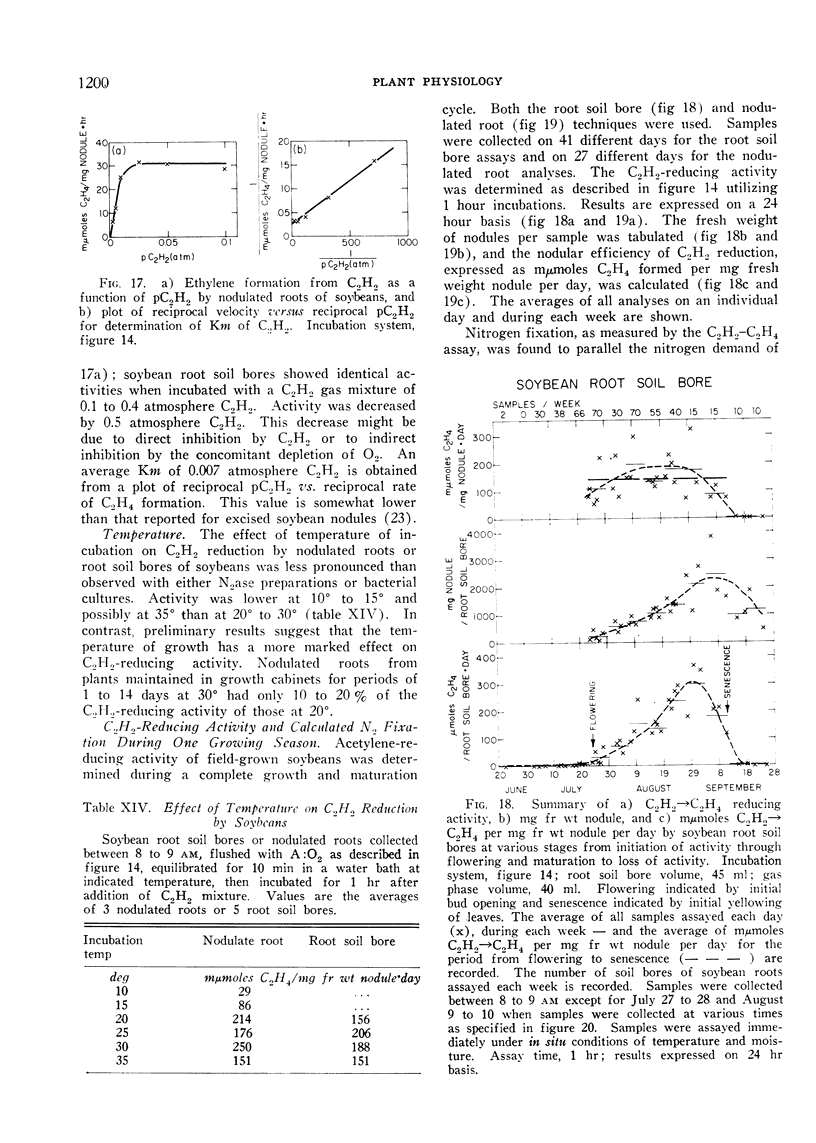Abstract
The methodology, characteristics and application of the sensitive C2H2-C2H4 assay for N2 fixation by nitrogenase preparations and bacterial cultures in the laboratory and by legumes and free-living bacteria in situ is presented in this comprehensive report. This assay is based on the N2ase-catalyzed reduction of C2H2 to C2H4, gas chromatographic isolation of C2H2 and C2H4, and quantitative measurement with a H2-flame analyzer. As little as 1 μμmole C2H4 can be detected, providing a sensitivity 103-fold greater than is possible with 15N analysis.
A simple, rapid and effective procedure utilizing syringe-type assay chambers is described for the analysis of C2H2-reducing activity in the field. Applications to field samples included an evaluation of N2 fixation by commercially grown soybeans based on over 2000 analyses made during the course of the growing season. Assay values reflected the degree of nodulation of soybean plants and indicated a calculated seasonal N2 fixation rate of 30 to 33 kg N2 fixed per acre, in good agreement with literature estimates based on Kjeldahl analyses. The assay was successfully applied to measurements of N2 fixation by other symbionts and by free living soil microorganisms, and was also used to assess the effects of light and temperature on the N2 fixing activity of soybeans. The validity of measuring N2 fixation in terms of C2H2 reduction was established through extensive comparisons of these activities using defined systems, including purified N2ase preparations and pure cultures of N2-fixing bacteria.
With this assay it now becomes possible and practicable to conduct comprehensive surveys of N2 fixation, to make detailed comparisons among different N2-fixing symbionts, and to rapidly evaluate the effects of cultural practices and environmental factors on N2 fixation. The knowledge obtained through extensive application of this assay should provide the basis for efforts leading to the maximum agricultural exploitation of the N2 fixation reaction.
Full text
PDF






















Selected References
These references are in PubMed. This may not be the complete list of references from this article.
- BULEN W. A., BURNS R. C., LECOMTE J. R. NITROGEN FIXATION: HYDROSULFITE AS ELECTRON DONOR WITH CELL-FREE PREPARATIONS OF AZOTOBACTER VINELANDII AND RHODOSPIRILLUM RUBRUM. Proc Natl Acad Sci U S A. 1965 Mar;53:532–539. doi: 10.1073/pnas.53.3.532. [DOI] [PMC free article] [PubMed] [Google Scholar]
- Bulen W. A., LeComte J. R. The nitrogenase system from Azotobacter: two-enzyme requirement for N2 reduction, ATP-dependent H2 evolution, and ATP hydrolysis. Proc Natl Acad Sci U S A. 1966 Sep;56(3):979–986. doi: 10.1073/pnas.56.3.979. [DOI] [PMC free article] [PubMed] [Google Scholar]
- CARNAHAN J. E., MORTENSON L. E., MOWER H. F., CASTLE J. E. Nitrogen fixation in cell-free extracts of Clostridium pasteurianum. Biochim Biophys Acta. 1960 Nov 18;44:520–535. doi: 10.1016/0006-3002(60)91606-1. [DOI] [PubMed] [Google Scholar]
- Campbell N. E., Dular R., Lees H. The production of 13-N2 by 50-MeV protons for use in biological nitrogen fixation. Can J Microbiol. 1967 May;13(5):587–599. doi: 10.1139/m67-076. [DOI] [PubMed] [Google Scholar]
- Detroy R. W., Witz D. F., Parejko R. A., Wilson P. W. Complementary functioning of two components required for the reduction of n2 from four nitrogen-fixing bacteria. Science. 1967 Oct 27;158(3800):526–527. doi: 10.1126/science.158.3800.526-c. [DOI] [PubMed] [Google Scholar]
- Dilworth M. J. Acetylene reduction by nitrogen-fixing preparations from Clostridium pasteurianum. Biochim Biophys Acta. 1966 Oct 31;127(2):285–294. doi: 10.1016/0304-4165(66)90383-7. [DOI] [PubMed] [Google Scholar]
- Dilworth M. J., Subramanian D., Munson T. O., Burris R. H. The adenosine triphosphate requirement for nitrogen fixation in cell-free extracts of Clostridium pasteurianum. Biochim Biophys Acta. 1965 Jun 22;99(3):486–503. doi: 10.1016/s0926-6593(65)80202-8. [DOI] [PubMed] [Google Scholar]
- HOCH G. E., SCHNEIDER K. C., BURRIS R. H. Hydrogen evolution and exchange, and conversion of N2O to N2 by soybean root nodules. Biochim Biophys Acta. 1960 Jan 15;37:273–279. doi: 10.1016/0006-3002(60)90234-1. [DOI] [PubMed] [Google Scholar]
- Hardy R. W., Knight E., Jr ATP-dependent reduction of azide and HCN by N2-fixing enzymes of Azotobacter vinelandii and Clostridium pasteurianum. Biochim Biophys Acta. 1967 May 16;139(1):69–90. doi: 10.1016/0005-2744(67)90114-3. [DOI] [PubMed] [Google Scholar]
- Hardy R. W., Knight E., Jr Reduction of N2O by biological N2-fixing systems. Biochem Biophys Res Commun. 1966 May 25;23(4):409–414. doi: 10.1016/0006-291x(66)90742-x. [DOI] [PubMed] [Google Scholar]
- Koch B., Evans H. J. Reduction of acetylene to ethylene by soybean root nodules. Plant Physiol. 1966 Dec;41(10):1748–1750. doi: 10.1104/pp.41.10.1748. [DOI] [PMC free article] [PubMed] [Google Scholar]
- Koch B., Evans H. J., Russell S. Properties of the nitrogenase system in cell-free extracts of bacteroids from soybean root nodules. Proc Natl Acad Sci U S A. 1967 Oct;58(4):1343–1350. doi: 10.1073/pnas.58.4.1343. [DOI] [PMC free article] [PubMed] [Google Scholar]
- Koch B., Evans H. J., Russell S. Reduction of acetylene and nitrogen gas by breis and cell-free extracts of soybean root nodules. Plant Physiol. 1967 Mar;42(3):466–468. doi: 10.1104/pp.42.3.466. [DOI] [PMC free article] [PubMed] [Google Scholar]
- MORTENSON L. E. A simple method for measuring nitrogen fixation by cell-free enzyme preparations of Clostridium pasteurianum. Anal Biochem. 1961 Jun;2:216–220. doi: 10.1016/s0003-2697(61)80003-1. [DOI] [PubMed] [Google Scholar]
- Mortenson L. E., Morris J. A., Jeng D. Y. Purification, metal composition and properties of molybdoferredoxin and azoferredoxin, two of the components of the nitrogen-fixing system of Clostridium pasteurianum. Biochim Biophys Acta. 1967 Aug 29;141(3):516–522. doi: 10.1016/0304-4165(67)90180-8. [DOI] [PubMed] [Google Scholar]
- Mortenson L. E., Mower H. F., Carnahan J. E. III. NITROGEN FIXATION BY ENZYME PREPARATIONS. Bacteriol Rev. 1962 Mar;26(1):42–50. doi: 10.1128/br.26.1.42-50.1962. [DOI] [PMC free article] [PubMed] [Google Scholar]
- Mustafa E., Mortenson L. E. Acetylene reduction by nitrogen fixing extracts of Clostridium pasteurianum: ATP requirement and inhibition by ADP. Nature. 1967 Dec 23;216(5121):1241–1242. doi: 10.1038/2161241a0. [DOI] [PubMed] [Google Scholar]
- NICHOLAS D. J., SILVESTER D. J., FOWLER J. F. Use of radioactive nitrogen in studying nitrogen fixation in bacterial cells and their extracts. Nature. 1961 Feb 25;189:634–636. doi: 10.1038/189634a0. [DOI] [PubMed] [Google Scholar]
- Schöllhorn R., Burris R. H. Acetylene as a competitive inhibitor of N-2 fixation. Proc Natl Acad Sci U S A. 1967 Jul;58(1):213–216. doi: 10.1073/pnas.58.1.213. [DOI] [PMC free article] [PubMed] [Google Scholar]
- Silver W. S. Biological nitrogen fixation. Science. 1967 Jul 7;157(3784):100–102. doi: 10.1126/science.157.3784.100. [DOI] [PubMed] [Google Scholar]
- Stewart W. D., Fitzgerald G. P., Burris R. H. In situ studies on N2 fixation using the acetylene reduction technique. Proc Natl Acad Sci U S A. 1967 Nov;58(5):2071–2078. doi: 10.1073/pnas.58.5.2071. [DOI] [PMC free article] [PubMed] [Google Scholar]


